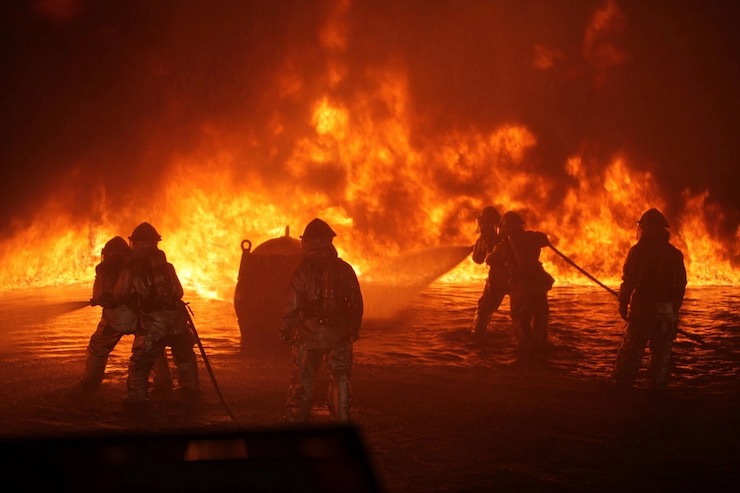Firefighters and Electric Companies Are Using Drones to Help Stop The Spread of Wildfires in California

In the future, there will be many books written about the events that took place over 2019-2020. What started with the worst wildfire season Australia had seen in years, progressed into a worldwide pandemic, a nearly out of control locust outbreak through much of Africa and Asia, and a massive explosion in Beirut, just to recall a few events. And now it seems we have circled back to yet another bout of devastating wildfires. Since the beginning of September, record breaking wildfires have been raging throughout California and the west coast of the United States.
Wildfires in California are not uncommon, every year the state goes through a wildfire season. After the 2018 season that saw the destruction of nearly 2 million acres of land and almost 25,000 structures. Not to mention it claimed the lives of 103 people and cost billions in damages. The 2019 fire season was relatively mild. Tensions were high going into this year’s wildfire season as the majority of the world has still been grappling with the spread of COVID. Once again, records are tragically being broken in California as large swaths of the state burn. Already more than 3 million acres of land (3% of the state’s total landmass) have been destroyed, marking the worst wildfire season in California’s history.
The fires are devastating, turning blue skies an eerie orange haze that is so poor in quality that breathing it in has been compared to smoking 20 packs of cigarettes a day. Through all of this, experts are looking for help from technology like drones to help curb the blazes. After the 2018 fires, especially the Camp Fire that was the worst of the year, rescuers and utility companies have turned to drones to help prevent the spread of fires. The Camp Fire, named after it’s place of origin Camp Creek Road, was started when a PG&E Corp. faulty C-hook broke and dropped a high voltage wire to the dry ground below. The resulting fire raged for 17 days and was the most destructive and deadly wildfire in California’s history at the time. This just proved how vital it is to maintain the integrity of the miles and miles of powerlines that cross through not only California, but the whole country. The reality though, is that sending crews out daily to check powerlines can be a relentless undertaking.
Not only is powerline monitoring dangerous, but it is extremely time consuming and costly. With drones, as PG&E has found out, this problem can be eliminated. In a matter of minutes, a drone can be sent up to inspect transmission towers and powerlines. The high definition camera on the drone can send the operator below instant, live images, and a data log to be further examined for the slightest faults. No longer do inspectors need to put themselves at unnecessary risk climbing towers just for an inspection. Instead, they can inspect in an hour what could have taken them up to a day or more to complete. As Mike Glass, director of data and analytics at PG&E’s IT organization said, “We firmly believe that over time, the entire industry—worldwide, globally—will eventually leverage some sort of remote technology to inspect electrical equipment. And we believe there will be increasing levels of automation and artificial intelligence inside of that process over time.”
Drones aren’t only being used to inspect utility towers and lines for fire prevention. Many state utility departments have begun using drones to inspect vegetation overgrowth around the powerlines as well. When tree branches and weeds are overgrown, they can pose serious electrical threats. Storms and high winds can cause branches to fall and tear down lines. Dry brittle weeds, shrubs, and grass are a recipe for disaster. But just like the unbelievable amount of time it takes to inspect and maintain powerlines, ensuring the vegetation is under control can also be a large burden. By sending a drone up, miles can be inspected and mapped in a fraction of the time. Once a map is in place, ground crews can be strategically sent to cut back any questionable areas of overgrowth.
Drones have also proven to be useful rescue tools for emergency workers to put out fires. While firefighters will do anything in their power to rescue civilians from a fire, drones have been vital in minimizing their personal risk. Before sending firefighters into a burning building, a drone can be used to create a thermal map of the structure. This map can then be used to pinpoint the exact location of any victims trapped inside. The map can show rescuers the most ideal way to reach these victims with the least amount of risk. Firefighters also use drones to track the progress of wildfires, helping them to predict where the fire will go, to get ahead of the blaze. And though they are not being used in wildfire tactics, sometimes drones have even been used to put out fires!
For the most part, drones are being used responsibly and as a tool to help battle wildfires. However, there are often reports of drones interfering with firefighting efforts. People are curious and drones can easily be used to capture images that quench that curiosity. However, flying a drone anywhere near a fire is illegal unless it is an FAA authorized drone/flight that is working with the fire department and rescuers directly. An unauthorized drone can harm the firefighters working to put out a fire. The FAA and all California fire management agencies want to remind the public of their slogan “If you fly, we can’t”. The goal is to fight the fires and protect lives, eventually healing the land. One way or another drones are sure to play a positive role in obtaining these goals.
|